parking sensors FIAT DOBLO COMBI 2015 2.G Owners Manual
[x] Cancel search | Manufacturer: FIAT, Model Year: 2015, Model line: DOBLO COMBI, Model: FIAT DOBLO COMBI 2015 2.GPages: 323, PDF Size: 46.77 MB
Page 14 of 323
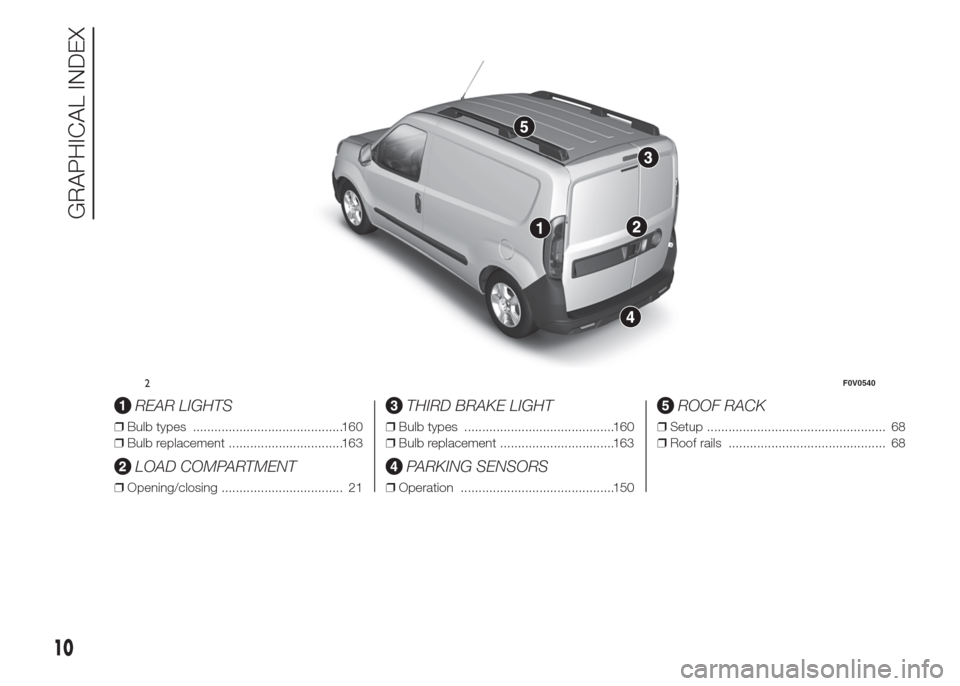
.
REAR LIGHTS
❒Bulb types ..........................................160
❒Bulb replacement ................................163
LOAD COMPARTMENT
❒Opening/closing .................................. 21
THIRD BRAKE LIGHT
❒Bulb types ..........................................160
❒Bulb replacement ................................163
PARKING SENSORS
❒Operation ...........................................150
ROOF RACK
❒Setup .................................................. 68
❒Roof rails ............................................ 68
2F0V0540
10
GRAPHICAL INDEX
Page 109 of 323
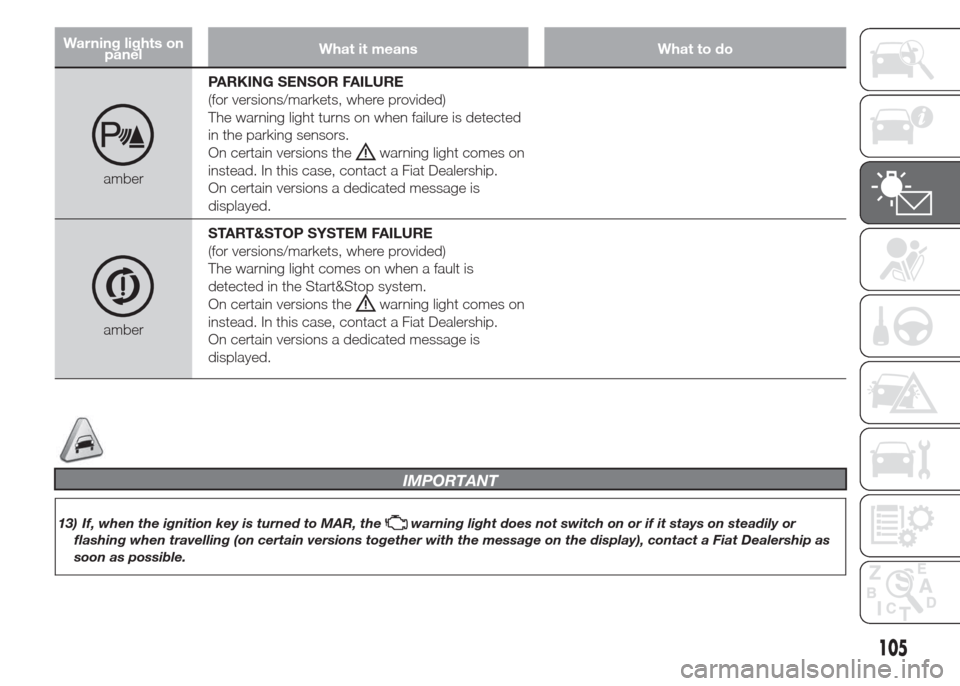
Warning lights on
panelWhat it means What to do
amberPARKING SENSOR FAILURE
(for versions/markets, where provided)
The warning light turns on when failure is detected
in the parking sensors.
On certain versions the
warning light comes on
instead. In this case, contact a Fiat Dealership.
On certain versions a dedicated message is
displayed.
amberSTART&STOP SYSTEM FAILURE
(for versions/markets, where provided)
The warning light comes on when a fault is
detected in the Start&Stop system.
On certain versions the
warning light comes on
instead. In this case, contact a Fiat Dealership.
On certain versions a dedicated message is
displayed.
IMPORTANT
13) If, when the ignition key is turned to MAR, thewarning light does not switch on or if it stays on steadily or
flashing when travelling (on certain versions together with the message on the display), contact a Fiat Dealership as
soon as possible.
105
Page 139 of 323
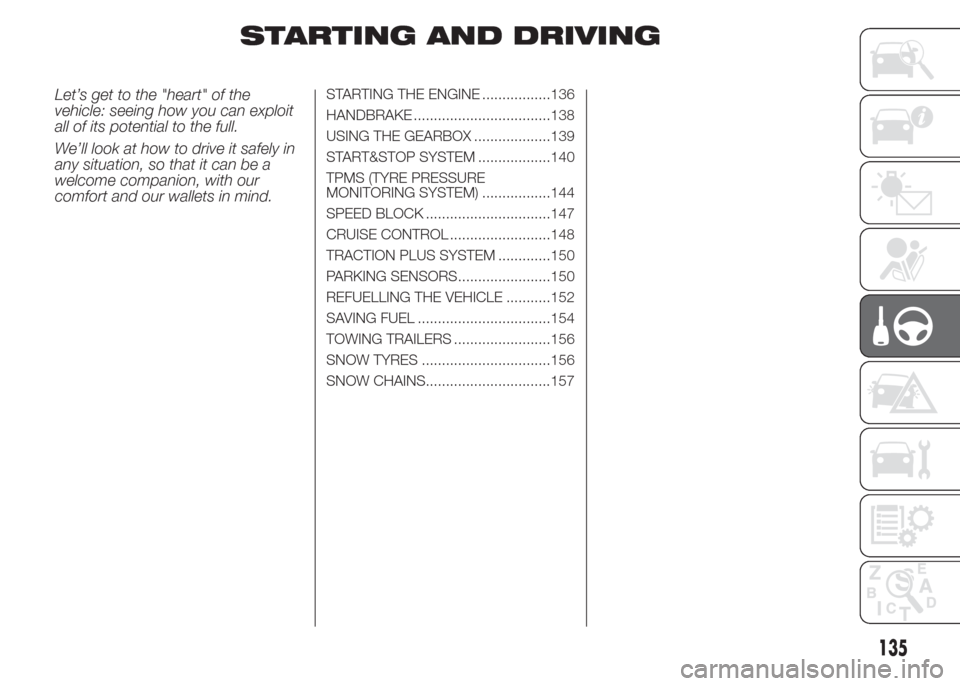
STARTING AND DRIVING
Let’s get to the "heart" of the
vehicle: seeing how you can exploit
all of its potential to the full.
We’ll look at how to drive it safely in
any situation, so that it can be a
welcome companion, with our
comfort and our wallets in mind.STARTING THE ENGINE .................136
HANDBRAKE ..................................138
USING THE GEARBOX ...................139
START&STOP SYSTEM ..................140
TPMS (TYRE PRESSURE
MONITORING SYSTEM) .................144
SPEED BLOCK ...............................147
CRUISE CONTROL .........................148
TRACTION PLUS SYSTEM .............150
PARKING SENSORS.......................150
REFUELLING THE VEHICLE ...........152
SAVING FUEL .................................154
TOWING TRAILERS ........................156
SNOW TYRES ................................156
SNOW CHAINS...............................157
135
Page 154 of 323

TRACTION PLUS
SYSTEM
(for versions/markets, where
provided)
Traction Plus is a driving aid, useful
for setting off in poor grip conditions
(snow, ice, mud, etc.) which allows
the drive force to be distributed in
the best way over the front axle
when one wheel is slipping.
Traction Plus acts by braking the
wheels with poor grip (or those
slipping more than the others),
thereby transferring the drive force
to those which have greater grip on
the ground.
This function can be activated
manually by pressing the A fig. 147
button on the control panel and
operates under 50 km/h. When this
speed is exceeded, it is
automatically deactivated and it is
reactivated again when the speed
falls below 50 km/h.Traction Plus
operation
The system is deactivated when
starting. To activate the Traction Plus
system press the A fig. 147 button.
The activation of the Traction Plus
system involves the following
functions being switched on:
❒inhibition of the ASR function, in
order to fully exploit the engine
torque;
❒the differential locking effect on the
front axle, through the braking
system, to improve traction
on irregular grounds.
If the Traction Plus system is faulty,
the
warning light on the
instrument panel switches on
constantly.
PARKING SENSORS
These are located in the rear
bumper fig. 148 and their function is
to inform the driver, through an
intermittent beeping noise, about
the presence of obstacles behind
the vehicle.
ACTIVATION
The sensors are automatically
activated when reverse is engaged.
As the obstacle behind the vehicle
gets closer to the bumper, the
frequency of the acoustic signal
increases.
147F0V0575
148F0V0077
150
STARTING AND DRIVING
Page 155 of 323
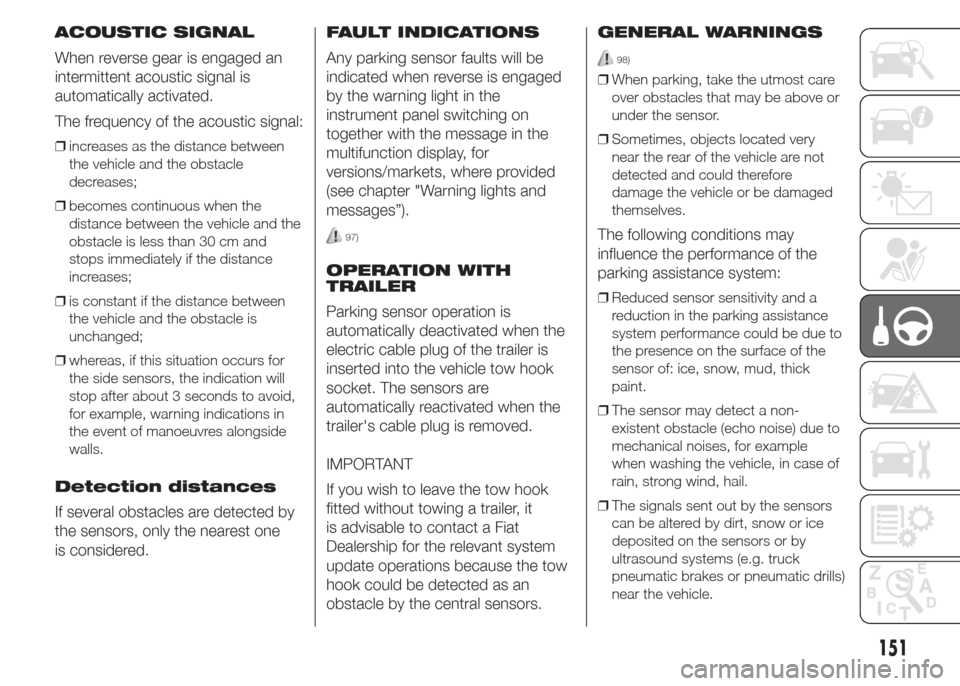
ACOUSTIC SIGNAL
When reverse gear is engaged an
intermittent acoustic signal is
automatically activated.
The frequency of the acoustic signal:
❒increases as the distance between
the vehicle and the obstacle
decreases;
❒becomes continuous when the
distance between the vehicle and the
obstacle is less than 30 cm and
stops immediately if the distance
increases;
❒is constant if the distance between
the vehicle and the obstacle is
unchanged;
❒whereas, if this situation occurs for
the side sensors, the indication will
stop after about 3 seconds to avoid,
for example, warning indications in
the event of manoeuvres alongside
walls.
Detection distances
If several obstacles are detected by
the sensors, only the nearest one
is considered.FAULT INDICATIONS
Any parking sensor faults will be
indicated when reverse is engaged
by the warning light in the
instrument panel switching on
together with the message in the
multifunction display, for
versions/markets, where provided
(see chapter "Warning lights and
messages”).
97)
OPERATION WITH
TRAILER
Parking sensor operation is
automatically deactivated when the
electric cable plug of the trailer is
inserted into the vehicle tow hook
socket. The sensors are
automatically reactivated when the
trailer's cable plug is removed.
IMPORTANT
If you wish to leave the tow hook
fitted without towing a trailer, it
is advisable to contact a Fiat
Dealership for the relevant system
update operations because the tow
hook could be detected as an
obstacle by the central sensors.GENERAL WARNINGS
98)
❒When parking, take the utmost care
over obstacles that may be above or
under the sensor.
❒Sometimes, objects located very
near the rear of the vehicle are not
detected and could therefore
damage the vehicle or be damaged
themselves.
The following conditions may
influence the performance of the
parking assistance system:
❒Reduced sensor sensitivity and a
reduction in the parking assistance
system performance could be due to
the presence on the surface of the
sensor of: ice, snow, mud, thick
paint.
❒The sensor may detect a non-
existent obstacle (echo noise) due to
mechanical noises, for example
when washing the vehicle, in case of
rain, strong wind, hail.
❒The signals sent out by the sensors
can be altered by dirt, snow or ice
deposited on the sensors or by
ultrasound systems (e.g. truck
pneumatic brakes or pneumatic drills)
near the vehicle.
151
Page 156 of 323
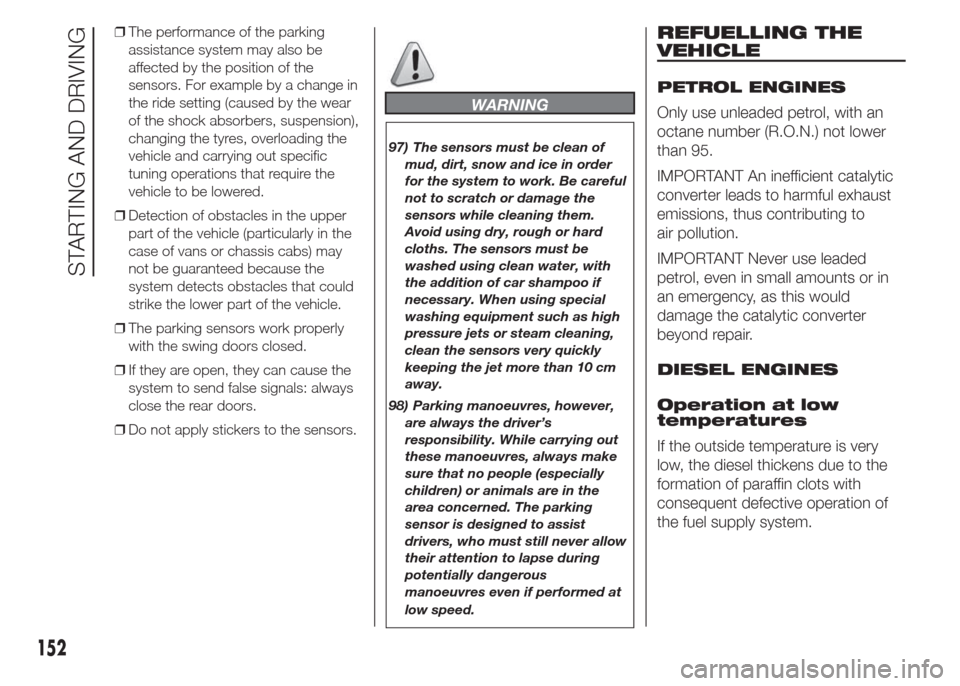
❒The performance of the parking
assistance system may also be
affected by the position of the
sensors. For example by a change in
the ride setting (caused by the wear
of the shock absorbers, suspension),
changing the tyres, overloading the
vehicle and carrying out specific
tuning operations that require the
vehicle to be lowered.
❒Detection of obstacles in the upper
part of the vehicle (particularly in the
case of vans or chassis cabs) may
not be guaranteed because the
system detects obstacles that could
strike the lower part of the vehicle.
❒The parking sensors work properly
with the swing doors closed.
❒If they are open, they can cause the
system to send false signals: always
close the rear doors.
❒Do not apply stickers to the sensors.
WARNING
97) The sensors must be clean of
mud, dirt, snow and ice in order
for the system to work. Be careful
not to scratch or damage the
sensors while cleaning them.
Avoid using dry, rough or hard
cloths. The sensors must be
washed using clean water, with
the addition of car shampoo if
necessary. When using special
washing equipment such as high
pressure jets or steam cleaning,
clean the sensors very quickly
keeping the jet more than 10 cm
away.
98) Parking manoeuvres, however,
are always the driver’s
responsibility. While carrying out
these manoeuvres, always make
sure that no people (especially
children) or animals are in the
area concerned. The parking
sensor is designed to assist
drivers, who must still never allow
their attention to lapse during
potentially dangerous
manoeuvres even if performed at
low speed.
REFUELLING THE
VEHICLE
PETROL ENGINES
Only use unleaded petrol, with an
octane number (R.O.N.) not lower
than 95.
IMPORTANT An inefficient catalytic
converter leads to harmful exhaust
emissions, thus contributing to
air pollution.
IMPORTANT Never use leaded
petrol, even in small amounts or in
an emergency, as this would
damage the catalytic converter
beyond repair.
DIESEL ENGINES
Operation at low
temperatures
If the outside temperature is very
low, the diesel thickens due to the
formation of paraffin clots with
consequent defective operation of
the fuel supply system.
152
STARTING AND DRIVING
Page 320 of 323
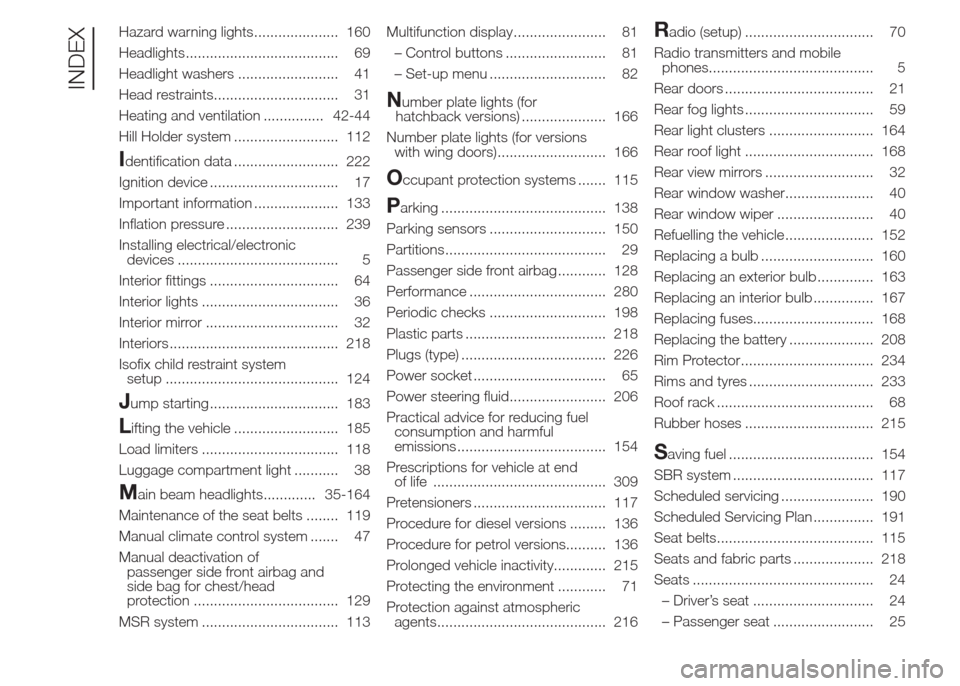
Hazard warning lights..................... 160
Headlights...................................... 69
Headlight washers ......................... 41
Head restraints............................... 31
Heating and ventilation ............... 42-44
Hill Holder system .......................... 112
Identification data .......................... 222
Ignition device ................................ 17
Important information ..................... 133
Inflation pressure ............................ 239
Installing electrical/electronic
devices ........................................ 5
Interior fittings ................................ 64
Interior lights .................................. 36
Interior mirror ................................. 32
Interiors .......................................... 218
Isofix child restraint system
setup ........................................... 124
Jump starting ................................ 183
Lifting the vehicle .......................... 185
Load limiters .................................. 118
Luggage compartment light ........... 38
Main beam headlights............. 35-164
Maintenance of the seat belts ........ 119
Manual climate control system ....... 47
Manual deactivation of
passenger side front airbag and
side bag for chest/head
protection .................................... 129
MSR system .................................. 113Multifunction display....................... 81
– Control buttons ......................... 81
– Set-up menu ............................. 82
Number plate lights (for
hatchback versions) ..................... 166
Number plate lights (for versions
with wing doors)........................... 166
Occupant protection systems ....... 115
Parking ......................................... 138
Parking sensors ............................. 150
Partitions........................................ 29
Passenger side front airbag ............ 128
Performance .................................. 280
Periodic checks ............................. 198
Plastic parts ................................... 218
Plugs (type) .................................... 226
Power socket ................................. 65
Power steering fluid........................ 206
Practical advice for reducing fuel
consumption and harmful
emissions ..................................... 154
Prescriptions for vehicle at end
of life ........................................... 309
Pretensioners ................................. 117
Procedure for diesel versions ......... 136
Procedure for petrol versions.......... 136
Prolonged vehicle inactivity............. 215
Protecting the environment ............ 71
Protection against atmospheric
agents.......................................... 216
Radio (setup) ................................ 70
Radio transmitters and mobile
phones......................................... 5
Rear doors ..................................... 21
Rear fog lights ................................ 59
Rear light clusters .......................... 164
Rear roof light ................................ 168
Rear view mirrors ........................... 32
Rear window washer...................... 40
Rear window wiper ........................ 40
Refuelling the vehicle ...................... 152
Replacing a bulb ............................ 160
Replacing an exterior bulb .............. 163
Replacing an interior bulb ............... 167
Replacing fuses.............................. 168
Replacing the battery ..................... 208
Rim Protector................................. 234
Rims and tyres ............................... 233
Roof rack ....................................... 68
Rubber hoses ................................ 215
Saving fuel .................................... 154
SBR system ................................... 117
Scheduled servicing ....................... 190
Scheduled Servicing Plan ............... 191
Seat belts....................................... 115
Seats and fabric parts .................... 218
Seats ............................................. 24
– Driver’s seat .............................. 24
– Passenger seat ......................... 25
INDEX